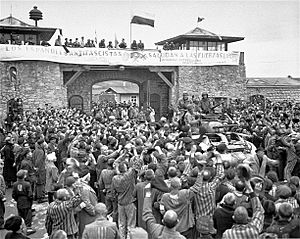Alfonsina Bueno facts for kids
Quick facts for kids
Alfonsina Bueno
|
|
|---|---|
| Birth name | Alfonsina Bueno Vela |
| Born | 26 January 1915 Moros, Zaragoza, Spain |
| Died | 3 January 1979 (aged 63) Tolosa, Occitania, France |
| Allegiance | |
| Service | |
| Years of service | 1941–1943 |
| Unit | |
| Battles/wars | World War II |
| Spouse(s) | Josep Ester i Borràs |
Alfonsina Bueno Vela (1915–1979) was a brave Spanish woman who helped fight against the Nazis during World War II. She joined a secret group called the French Resistance in 1941.
With her husband, Josep Ester i Borràs, and their daughter, Angelina, she ran a secret house. This house helped Allied airmen (pilots and crew from countries fighting the Nazis) escape to safety. Sadly, she was caught by the Gestapo (the Nazi secret police). She was then sent to a terrible prison camp called Ravensbrück concentration camp in Germany. While there, Nazi doctors did harmful medical tests on her without her permission.
Alfonsina's brave actions were recognized and praised by the governments of Britain, France, and the United States.
Early Life
Alfonsina Bueno was born in Moros, Spain on January 26, 1915. Her family moved to a town called Berga when she was a child.
She worked in a textile factory where she met Josep Ester Borràs. They later got married and had one child together.
Fighting in the Resistance
After World War II began, Alfonsina joined the French Resistance in 1941. She became part of a special group known as the Ponzán group.
With her daughter Angelina, she managed a house in Banyuls-sur-Mer, France. This house was a safe place for French fighters called Maquis. It also helped Allied airmen use the Pat O'Leary Line, which was a secret escape route to England.
In February 1943, the Gestapo found out about their house. Alfonsina was arrested. Her husband was also arrested later in October 1943. He was held in prisons in Toulouse and Paris.
Alfonsina was first imprisoned in Toulouse. Then, in May 1944, she was sent to Ravensbrück concentration camp in Germany. This was part of a Nazi plan called Nacht und Nebel (Night and Fog). This plan was designed to make political prisoners disappear. At Ravensbrück, Nazi doctors performed harmful medical tests on her without her consent. Other women died from these procedures.
In March 1945, she was moved to Mauthausen concentration camp. There, she was reunited with her husband. They were both freed in May 1945 when the war ended.
The difficult experiences she faced during the war left Alfonsina in poor health. She was unable to have more children. Later, she and her husband separated. He wanted to share the truth about the terrible things that happened to them, but she wanted to forget. Alfonsina died in Toulouse in 1979.
Legacy
Alfonsina Bueno's brave work in the resistance movement was honored by the British, French, and US governments.
A book called Noche y niebla en los campos nazis by Mónica G. Álvarez tells the stories of Alfonsina and ten other women who were held in Nazi camps. A special mural in Berga remembers Alfonsina's life and courage.
See also
 In Spanish: Alfonsina Bueno para niños
In Spanish: Alfonsina Bueno para niños


